Round The World and other travels
A frequent flyer's collection of trip diaries
This is: Russia & Sweden 2014
Culture and Canals
The weather breaks
We were ready to set out for our first full day's exploration in St Petersburg by about 0930, following a satisfying breakfast in the hotel's ground-floor restaurant. The weather had indeed changed overnight: although conditions were still dry and warm at this point, the sky was leaden and there was an uncomfortably strong wind blowing. The first objective was to have a closer look at the nearby St Isaac's Cathedral, one of the largest domed churches in the world, commissioned by Tsar Alexander I in 1818 to celebrate his victory over Napoleon. The guide books promised a lavishly decorated interior featuring malachite, lazulite, marble and other stones and minerals, and it was evident from the street that the outer colonnade beneath the dome would offer fine views over the city. While we were waiting for the ticket office to open at 10am, the weather finally broke: suddenly the rain was lashing down, made all the worse by strong winds, and people were sent scurrying for cover. Once it became clear that these conditions were set to endure for more than a few minutes, a tactical retreat to base was called for, in order to make suitable modifications to our clothing.
When we set out once more into the deluge, just a few minutes later, we decided to give the cathedral a miss for the time being, on the grounds that climbing up to the viewing gallery would not be a good idea in such weather. (In the event, sadly, we would never have time to return for a second attempt at seeing the building.) Instead, we headed directly to St Petersburg's most celebrated attraction, which could be appreciated from indoors.
Winter Palace and State Hermitage Museum
| RIGHT: Thursday morning in Palace Square and it's wet, wet, wet! |
 |
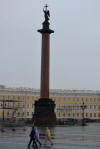 |
 |
That celebrated attraction was, of course, the Winter Palace, home of the world-famous State Hermitage Museum. We soon found ourselves in Palace Square amid unrelenting rain, with the palace to our left.
 Now was not the time to dwell on external features:
our place was
clearly indoors where we could stay dry while enjoying one of the
world's greatest art collections, which included the largest
single collection of paintings on earth. The museum was founded by
Catherine the Great in 1764 and has been open to the public since
the middle of the nineteenth century. Right from the moment when we
entered via the magnificent, red-carpeted Jordan Staircase, I
repeatedly thought to myself that this had to be the most
sumptuously presented art collection that I had ever seen.
Now was not the time to dwell on external features:
our place was
clearly indoors where we could stay dry while enjoying one of the
world's greatest art collections, which included the largest
single collection of paintings on earth. The museum was founded by
Catherine the Great in 1764 and has been open to the public since
the middle of the nineteenth century. Right from the moment when we
entered via the magnificent, red-carpeted Jordan Staircase, I
repeatedly thought to myself that this had to be the most
sumptuously presented art collection that I had ever seen.
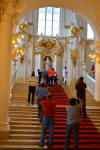 |
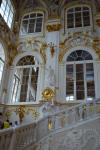 |
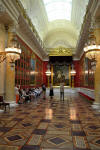 |
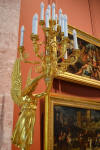 |
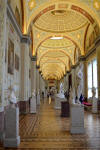 |
 |
 |
|||||
 |
 |
 |
 |
 |
 |
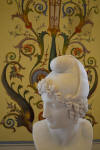 |
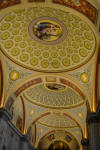 |
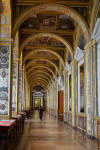 |
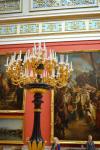 |
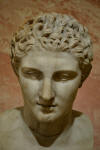 |
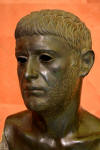 |
We spent two absorbing hours viewing the various rooms and galleries, which was probably enough without going into culture overload.
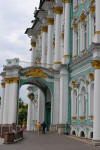 |
 |
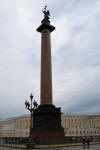 |
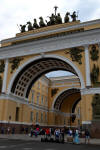 |
 |
|||
| ABOVE: Second time in Palace Square and the weather is definitely improving | |||
Emerging back into the open air, it was good to see that the weather was clearing up nicely, offering more favourable conditions in which to take in our surroundings. Facing the Winter Palace across Palace Square was the General Staff Building, Europe's longest. The centrepiece of the square was the 156-foot-tall Alexander Column, a memorial to Russia’s victory over Napoleon. Cut from a single piece of granite and weighing more than 650 tons, it was commissioned by Tsar Nicholas I in 1830 in memory of his brother, Tsar Alexander I. Remarkably, the column stands in place by the sheer force of its own weight; there are no attachments fixing it to the pedestal. This knowledge, I have to confess, gave me a somewhat uneasy feeling when walking past the monument!
Nevsky Prospekt
 |
 |
 |
| ABOVE: Kazan Cathedral on Nevsky Prospekt | ||
We then walked the short distance to St Petersburg's main shopping street, Nevsky Prospekt, where the most spectacular sight turned out to be Kazan Cathedral, a larger-than-life neoclassical construction dating from the early nineteenth century. The architect is said to have drawn inspiration from St Peter's Basilica in Rome. During the communist era, the building served as a museum of religion and atheism, with the emphasis on the latter.
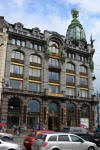 |
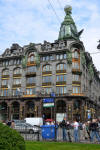 |
 |
| LEFT and ABOVE: Café Singer proved to be a noteworthy and enjoyable lunch stop. |
Directly opposite the cathedral stood another notable building. Singer House, also known as the House of Books, was originally the Russian branch of the well-known sewing machine company and the attractive Art Nouveau structure that we saw had resulted from rejection of the company's original plan to build a skyscraper on the site.
Today, the building houses a bookstore and a pleasant eatery by the name of Café Singer, the latter of which provided the perfect venue in which to enjoy some midday sustenance with a fine view of the cathedral opposite. Despite the prime location, the prices seemed entirely reasonable when compared to those in Moscow.
Arts Square and central district
 |
 |
| ABOVE: Along the Griboyedova canal | |
 |
 |
| ABOVE: Russian Museum, Arts Square | |
Our lunch venue occupied a corner site on Nevsky Prospekt adjacent to the Griboyedova canal, and our initial route after lunch took us along the banks of that waterway. Veering off to the right, we passed through the attractive Arts Square, home to both the Mikhailovsky Theatre and the Russian Museum.
The next notable building to come into sight was the orange-hued St. Michael’s (Mikhailovsky) Castle, once belonging to one of Russia’s strangest and most pitiful leaders. Paul I grew up in the shadow of his mother, Catherine the Great, whom he despised, blaming her (no doubt correctly) for the death of his father. By the time Paul became tsar, he was terrified of being murdered like his father, and built the castle as a supposedly impenetrable fortress. The Fontanka and Moika rivers cut off access from the north and east, and he installed moats and secret passageways everywhere else. All his intricate planning came to naught though, because on 24 March 1801, a month after he moved in, he was suffocated with a pillow in his bed. Historians speculate that Alexander I was at least complicit, and possibly even directly involved.
Strolling through a small park opposite the castle and benefitting from the shade offered on what was now a gloriously sunny afternoon, we soon came to the rather strangely named Church of the Saviour on Spilled Blood. Architect Alfred Parland was consciously aiming to copy St. Basil’s in Moscow, and the result is an ornate, old-Russian style church. Commissioned by Tsar Alexander III to commemorate the death of his father, Alexander II, murdered by a terrorist explosion on the site in 1881, the 81-metre height of the cathedral symbolizes the year of his death. The church opened officially in 1907, but was closed by Stalin in the 1930s and suffered major damage during the second world war. Meticulously restored in the years since the fall of the Soviet Union, it finally reopened at the end of the 20th century.
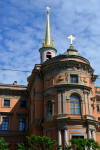 |
LEFT: St Michael's Castle |
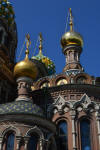 |
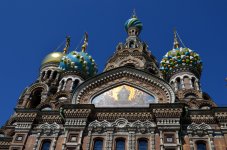 |
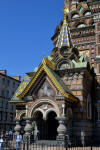 |
| RIGHT: Cathedral of the Resurrection of Christ, better known as the Church of the Saviour on Spilled Blood |
After viewing the church, we spent some time simply strolling around the sun-drenched and relatively quiet streets along the Moika river.
| RIGHT: A short afternoon walk along the Moika riverbanks |
 |
 |
 |
 |
 |
 |
 |
 |
LEFT: Third time in Palace Square and it's now glorious! |
As we did so, we were on the lookout for a possible canal cruise. Not seeing anything in the locality that particularly took our fancy, we decided to head back out to the main Neva river. This took us through Palace Square for the third time, the cloudless sky providing an astonishing contrast with our previous two visits earlier in the day.
River and canal cruise
Our new strategy proved to be an instant success, and in no time at all we were enjoying a very pleasant end to the day seeing the canals from a different perspective.
 |
 |
 |
 |
 |
 |
 |
 |
 |
 |
 |
 |
Evening
A relatively short walk then brought us back to the Renaissance Baltic for a well earned rest and the customary evening cocktail. In due course we once again walked towards the Nevsky Prospekt area in search of a light evening meal.